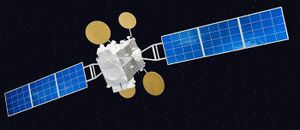Engineering:Amos-5
 | |
| Mission type | Communications |
|---|---|
| Operator | |
| COSPAR ID | 2011-074A |
| SATCAT no. | 37950 |
| Website | Amos-Spacecom |
| Mission duration | Planned: 15 years; Achieved: 3 years, 11 months and 10 days |
| Spacecraft properties | |
| Bus | Express 1000H |
| Manufacturer | |
| Launch mass | 1,972 kilograms (4,348 lb)[2] |
| Power | 5600 W |
| Start of mission | |
| Launch date | 11 December 2011, 11:17 UTC |
| Rocket | Proton-M/Proton |
| Launch site | Baikonur |
| End of mission | |
| Deactivated | 21 November 2015[3] |
| Orbital parameters | |
| Reference system | Geocentric |
| Regime | Geostationary |
| Longitude | 17° East |
| Transponders | |
| Band | 14 C band 72 MHz × 4 C × 36 MHz, 18 Ku band × 72 MHz |
| EIRP | 45,5 dBW (C-Band) 52,5 dBW (Ku-Band)[4] |
Amos-5 (Hebrew: עמוס 5) was an Israeli commercial communication satellite, part of the AMOS series of satellites. It was developed and built for Spacecom by NPO PM, the largest Russian satellite producer, at a cost of $157 million. The satellite was positioned at the 17° East longitude in the geostationary belt. It was launched on 11 December 2011, 11:17 UTC from Baikonur, Kazakhstan,[2][5] atop a Proton-M/Briz-M launch vehicle. It provided coverage over the continent of Africa, as well as Europe and the Middle East.
Following failure of power generator 1, generator 2 was activated in May 2012. Power generator 2 also developed faults in September 2012 and October 2013 and the satellite's initial lifespan of 15 years was expected to be shortened by 11 months. However all communications with the Amos-5 satellite were lost on 21 November 2015. [3] The satellite was visualized in its expected location, moving in an uncontrolled fashion, most likely due to power failure. Three weeks later, Spacecom announced that the satellite had failed completely. It is expected to continue to orbit at an altitude of 42,000 km for the foreseeable future.
See also
- 2011 in spaceflight
- Amos (satellite)
- List of broadcast satellites
- Spacecom
References
- ↑ Amos-5 Brochure. Israel: Spacecom. 2012. pp. 1. http://www.amos-spacecom.com. Retrieved 2014-04-14.
- ↑ 2.0 2.1 "AMOS-5". JSC Information Satellite Systems. http://www.iss-reshetnev.com/?cid=geoca&caid=47. Retrieved 14 April 2014.
- ↑ 3.0 3.1 "Contact Lost With Israeli Communication Satellite Amos 5". http://www.haaretz.com/israel-news/business/1.687543.
- ↑ amos-spacecom: Technical Profile AMOS 5 (PDF; 1,8 MB)
- ↑ "Amos 5 satellite launched into space". http://www.ynetnews.com/articles/0,7340,L-4159943,00.html.
External links

